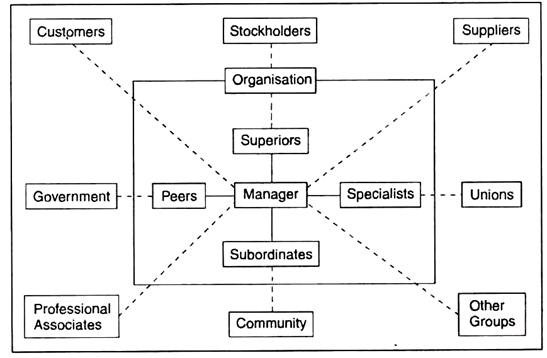The following points highlight the eight major areas in which businesses should set objectives identified by Peter Drucker. Also we will learn about the need for balancing these multiple objectives.
Area # 1. Market Standing:
A business must set objectives concerning what share of the market it will try to capture.
The best market share requires careful analysis of:
(i) Customers and products or services,
ADVERTISEMENTS:
(ii) Market segments (what groups of customers are buying the product or services), and
(iii) Distribution channels (the methods adopted for getting the product to the customers).
The product-market matrix of Ansoff is most relevant and therefore, should be pursued.
Area # 2. Productivity:
Productivity or efficiency is the ratio of an organisation’s inputs to outputs. It is concerned with the determination and balancing of inputs of material, labour, equipment, finance and managerial skills to produce the firm’s outputs.
ADVERTISEMENTS:
For example: when a firm cuts its employees turnover rate, the costs of hiring and training new employees drops—this results in increased productivity; or when material specifications are changed in association with an improved equipment, the overall productivity may increase.
Thus, the productivity objectives can be set in several areas, including work methods, machinery synchronising and increased worker efficiency.
Area # 3. Physical and Financial Resources:
This is concerned with the generation and utilisation of financial resources coupled with the organisation of physical resources like men, materials and machinery. So, the objectives should be established regarding plant and equipment and human resources and supply of raw materials.
Area # 4. Profitability:
Profit objectives are important to accomplish other objectives including:
ADVERTISEMENTS:
(i) The research and development needed for innovation of products and processes,
(ii) The financial strength to update the plant and equipment, and
(iii) The salaries needed to attract outstanding personnel.
Area # 5. Innovation:
Innovation is the hallmark of progress and prosperity though associated with high degree of risk and uncertainty. There is a great need for new and innovative products and services. Even if it is a risk in being the first with something new, it has potentials of high rewards.
Area # 6. Management Development:
ADVERTISEMENTS:
The survival of any organisation depends on this. Smaller firms are especially vulnerable, since the management expertise often rests with one or a few talented managers. So the organisations, whether large or small, must set objectives relating to the quality of management performance and to ensuring the development of managers at all levels.
Management development is one of the strategic issues for corporate governance and development particularly when Strategic Business Units (SBUs) are formed for various strategic decisions and actions.
Area # 7. Worker Performance and Attitudes:
In every organisation, most of the routine tasks are performed by the operative-level employees. The operations of many large and small firms are disrupted by strikes. The managers of smaller non-union firms become alarmed when their workers talk of organising or joining a union.
The firms seeking search for effectiveness should set objectives on workers’ performance and attitudes having due regard to such factors as output per man-day, product specification and quality, and level of employee morale.
Area # 8. Public and Social Responsibility:
ADVERTISEMENTS:
‘The profit ethic—the idea that business is to maximise profit— once served the purpose. Today this ethic cannot be used since there are goals other than profit’. An organisation must operate at maximum economic efficiency to get rid of the evil connotations attached to the word ‘profit’. According to Chads F. Phillips, ‘business should seek society’s good in ways that are also good for business’.
In this respect, Peter Drucker himself said ‘Neither results nor resources exist inside the business. Both exist outside. The business enterprise should be so managed so as to make the public good become the private good of the enterprise.’ Thus, big firms should set this criteria as one of their objectives.
Need for Balancing Objectives:
We find that most organisations have multiple objectives which require them to make trade -offs in order to accomplish all the objectives. These trade-offs, in turn, cause conflict in the ends and means necessary for achieving them. In short, multiple goals require balancing and accommodating the wants, needs and requirements of diverse groups as those shown below.
Management must determine the optimum balance or mix of these objectives. For example, the interests of stockholders, workers, and society are quite different. Shareholders want larger dividends; customers want better quality products or services at lower prices; workers want higher wages and paid off-days; and society at large expects high standards of socially responsible business actions.
ADVERTISEMENTS:
Consequently, management must exercise considerable judgment in setting multiple objectives that allow flexibility and trade-offs in reflecting the interest of each key group.
The delicate balance of organisational objectives means that departments and individuals will periodically contradict over what is considered acceptable behaviour. It is of utmost importance that top management clearly communicates the objectives of each department to the other departments to minimise conflicts, contradictions and misunderstandings.
